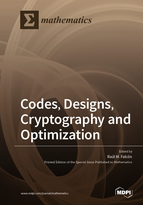Codes, Designs, Cryptography and Optimization
A special issue of Mathematics (ISSN 2227-7390). This special issue belongs to the section "E1: Mathematics and Computer Science".
Deadline for manuscript submissions: closed (31 January 2021) | Viewed by 30275
Special Issue Editor
Interests: discrete mathematics; graph theory; combinatorics; computational geometry; Latin squares
Special Issues, Collections and Topics in MDPI journals
Special Issue Information
Dear Colleagues,
The aim of this Special Issue is to publish original research articles covering recent advances in any of the areas included in coding theory, cryptography, combinatorial design. and combinatorial optimization, with particular emphasis on establishing new synergies among them, and new applications to other fields and to the real world, including algebraic geometry, artificial intelligence, communication networks, computer science, hardware and software design, design of experiments, logistics, machine learning, and scheduling or transportation networks, amongst others.
Potential topics of this Special Issue include but are not limited to the following:
- Algebraic coding theory;
- Algorithm design and analysis;
- Block design theory;
- Computational complexity;
- Discrete structures: Enumeration and classification;
- Error-correcting and error-detecting codes;
- Finite geometry;
- Graph theory;
- Modeling combinatorial optimization problems;
- Network design and analysis;
- Orthogonal arrays;
- Pseudorandom sequences;
- Quantum cryptography;
- Quasigroup theory;
- Secret sharing schemes.
Dr. Raúl M. Falcón
Guest Editor
Manuscript Submission Information
Manuscripts should be submitted online at www.mdpi.com by registering and logging in to this website. Once you are registered, click here to go to the submission form. Manuscripts can be submitted until the deadline. All submissions that pass pre-check are peer-reviewed. Accepted papers will be published continuously in the journal (as soon as accepted) and will be listed together on the special issue website. Research articles, review articles as well as short communications are invited. For planned papers, a title and short abstract (about 100 words) can be sent to the Editorial Office for announcement on this website.
Submitted manuscripts should not have been published previously, nor be under consideration for publication elsewhere (except conference proceedings papers). All manuscripts are thoroughly refereed through a single-blind peer-review process. A guide for authors and other relevant information for submission of manuscripts is available on the Instructions for Authors page. Mathematics is an international peer-reviewed open access semimonthly journal published by MDPI.
Please visit the Instructions for Authors page before submitting a manuscript. The Article Processing Charge (APC) for publication in this open access journal is 2600 CHF (Swiss Francs). Submitted papers should be well formatted and use good English. Authors may use MDPI's English editing service prior to publication or during author revisions.
Keywords
- Association schemes
- Block design
- Cryptosystems
- Difference sets
- Hadamard matrices
- Latin squares
- Lattices
- Matroids
- Networks
- Orthogonal arrays
Benefits of Publishing in a Special Issue
- Ease of navigation: Grouping papers by topic helps scholars navigate broad scope journals more efficiently.
- Greater discoverability: Special Issues support the reach and impact of scientific research. Articles in Special Issues are more discoverable and cited more frequently.
- Expansion of research network: Special Issues facilitate connections among authors, fostering scientific collaborations.
- External promotion: Articles in Special Issues are often promoted through the journal's social media, increasing their visibility.
- Reprint: MDPI Books provides the opportunity to republish successful Special Issues in book format, both online and in print.
Further information on MDPI's Special Issue policies can be found here.






